Session dynamics of bioelectrical activity of the brain during intellectual computer work
Recieved: 02/12/2019
Accepted: 12/27/2019
Published: 03/31/2020
Pages: 78-93
DOI: 10.11621/npj.2020.0108
Keywords: bioelectrical activity of the brain; cognitive processes; biorhythm of the brain; interaction with a computer; positional game
Available online: 31.03.2020
Klochkova Olga I. , Shabanov Gennady A. (2020). Session dynamics of bioelectrical activity of the brain during intellectual computer work. National Psychological Journal, (1) , 78-93. https://doi.org/10.11621/npj.2020.0108
Copied to Clipboard
CopyAbstract
Background. Registration and analysis of bioelectric activity of the brain while performing the mental task allows us to obtain objective information about the physiological processes of the brain.
The Objective of the paper is to analyse session dynamics of changes in Theta rhythm(4-8 Hz), Delta rhythm (1-3.99 Hz), as well as slow (0.99-0.1 Hz) biorhythms of the human brain by registering the spectrum of the difference function of bioelectric activity (FBA) in the process of positional computer game.
Design. The efficiency of positional computer game of 65 female subjects in the age range of 18-58 years was analyzed. In 7 players in the course of four sessions of the game, the bioelectric activity of the brain in the range from 8 Hz to 0.13 Hz was studied.
Results. It is shown that the difference function of bioelectric activity at the significance level p=0.05 differs for each hemisphere in the frequency range. The changes in the frequencies of excitation (maxima) and inhibition (minima) of the difference function of bioelectric activity of the brain with an increase in the number of game sessions in each hemisphere in the ranges of theta, Delta and slow rhythms are revealed. A psychophysiological model of the player’s operations is proposed, which is consistent with the obtained data. The Statistica 10.0 package was used for statistical analysis.
Conclusion. In the final sessions of the positional computer game, the activity of the left hemisphere is reduced than the right one. As the strategy of the game has already been tested, the main elements of the game are already in memory, the novelty is almost absent. This is consistent with the transition from a successive (step-bystep) method of information processing to a simultaneous (one-step) analysis of the game position, which is characterized by rapid automatism in decision-making and performance.
Table 1. Session samples of the clicks
|
Session N |
Mean clicks NПр |
Median NПр |
Max NПр |
Min NПр |
|
Session 1 |
5.42+1.99 |
6.00 |
7.50 |
1.94 |
|
Session 2 |
4.92+1.71 |
4.61 |
7.72 |
2.89 |
|
Session 3 |
4.89+1.97 |
4.44 |
8.72 |
3.05 |
|
Session 4 |
4.08+1.38 |
4.50 |
5.56 |
2.39 |
Table 2. The beginning of the influence of memory in the process of the positional computer game
|
|
Session 1 |
Session 2 |
Session 3 |
Session 4 |
|
Mean N of the first memory click |
27.86 |
16.48 |
21.14 |
19.86 |
|
Mean time of the beginning in memory change (с) |
7.57 |
4.67 |
5.11 |
5.20 |
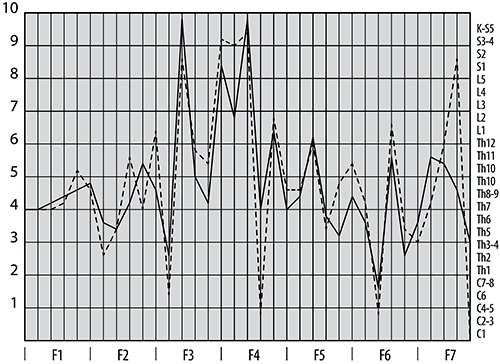
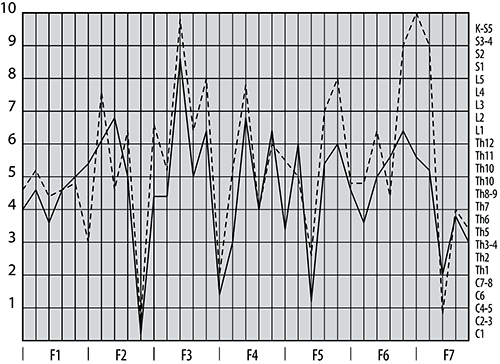
Fig. 1. Graph of the FBA amplitude (bioelectric activity function) values in the theta spectrum frequency range.
NB: the amplitude along the ordinate axis is in relative units, the abscissa shows frequency functions, the solid line is the right hemisphere, and the dotted line is the left hemisphere.
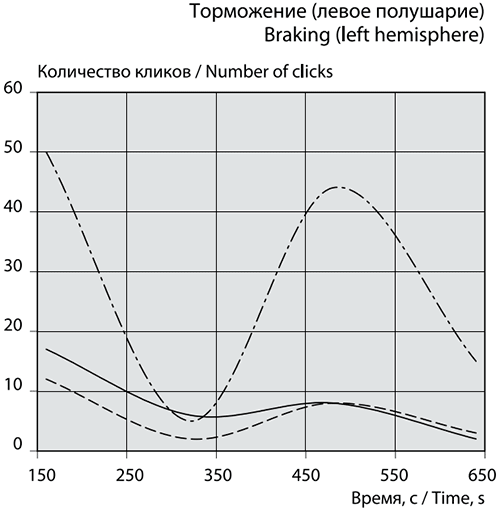
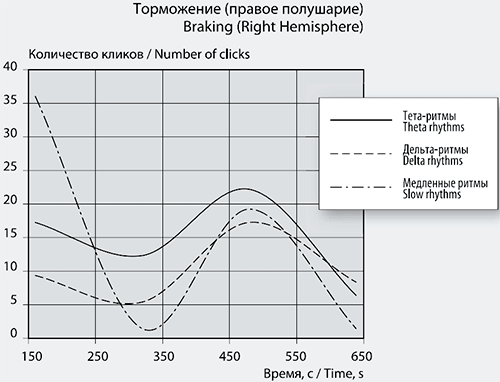
Fig. 2. Time session dynamics of the maxima number (upper row) and minima number (lower row) of the FBA spectral difference.
NB: The results of the left hemisphere are in the left column, the results of the right hemisphere are in the right column. On the abscissa axis, time increments are 160s; on the ordinate axis, there are the number of peaks whose frequencies are in the corresponding range.

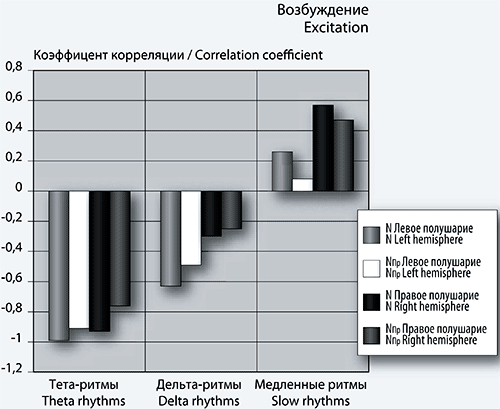
Fig. 3. Bar graphs show the correlation coefficients of the maximums spectrum (left), minimums spectrum (right) and the FBA number of clicks N and NПр.
NB: the X-axis shows the range of spectra, the Y-axis shows the values of the correlation coefficients.
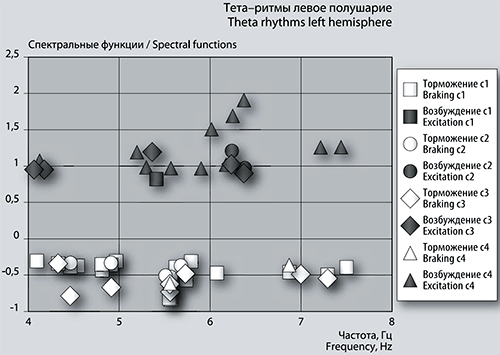
Fig. 4a. Time session schedule of the spectral FBA amplitude dependence on the maximum frequencies in the Theta rhythm range in the left hemisphere.
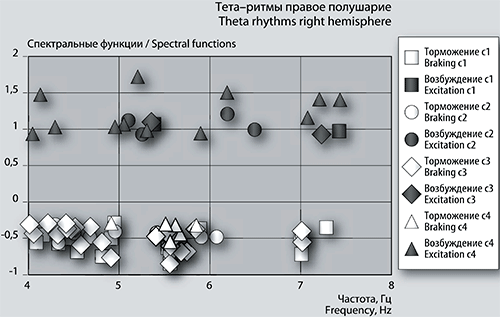
Fig. 4b. Time session schedule of the spectral FBA amplitude dependence on the frequencies of maxima and minima in the range of Theta rhythms in the right hemisphere
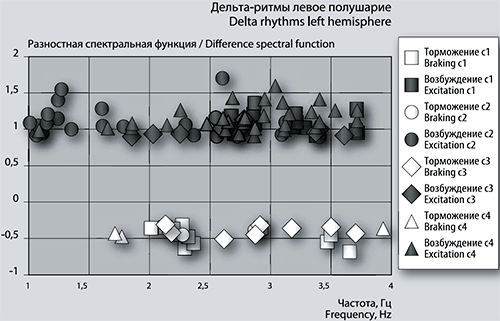
Fig. 5a. Graph of the time session of the spectral FBA amplitude dependence on the frequencies of the maxima in the range of delta rhythms in the left hemisphere.
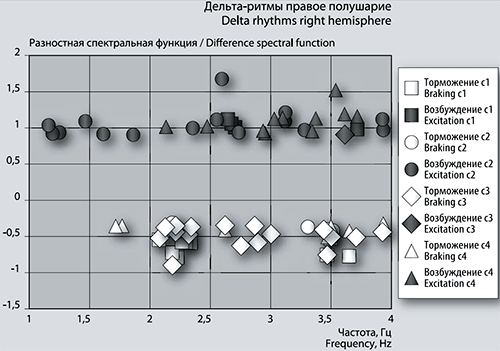
Fig. 5b. Graph of the time session of the spectral FBA amplitude dependence on the frequencies of the maxima in the range of delta rhythms in the right hemisphere.
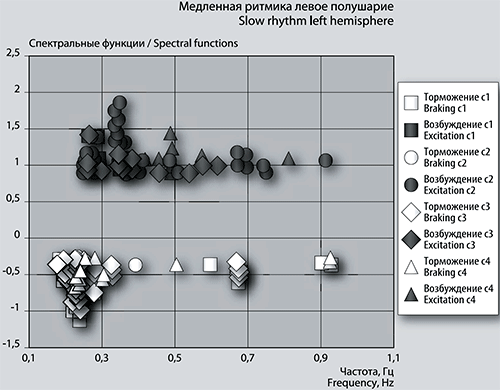
Fig. 6a. Graph of the session (time) dependence of the spectral FBA amplitude on the frequencies of maxima and minima in the range of slow rhythms in the left hemisphere.
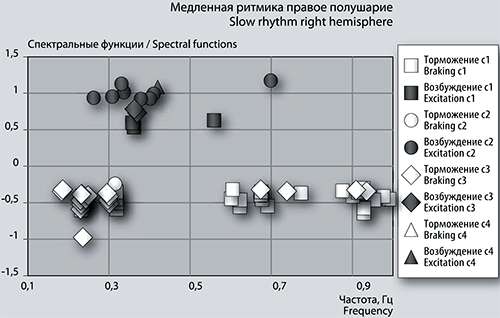
Fig. 6b. Graph of the time session of the spectral FBA amplitude dependence on the frequencies of maxima and minima in the range of slow rhythms in the right hemisphere.
References
Başar E. (2006). The theory of the whole-brain-work. Int J Psychophysiol, 60(2),133–138. Epub 2006 Mar 24 doi: 10.1016/j.ijpsycho.2005.12.007
Buzsáki G., & Draguhn A. (2004). Neuronal oscillations in cortical networks. Science, 304(5679), 1926–1929. doi: 10.1126/science.1099745
Chernorizov A.M., Isaychev E.S., & Isaychev S.A. (2018). A Complex Psychophysiological Approach to the Analysis of Human Brain and Behavior Responses to Detect an Intentionally Hidden Information. International Journal of Psychophysiology, Elsevier BV (Netherlands), 131, 126–127 doi:10.1016/j.ijpsycho.2018.07.340
Christoff K. (2012). Undirected thought: neural determinants and correlates. Brain Res. 2012 Jan 5, 1428, 51–59. doi: 10.1016/j.brainres.2011.09.060
Danilova N.N. (2012). Oscillatory systems and mental processes: Identification of target stimulus in experiments with working memory. International Journal of Psychophysiology, Elsevier BV (Netherlands), 85(3), 306–306 doi: 10.1016/j.ijpsycho.2012.06.048
Danilova Nina N., & Strabykina Elena A. (2010). Frequency-selective generators of oscillatory brain activity allow identifying processes of a working memory. International Journal of Psychophysiology, Elsevier BV (Netherlands), 77(3), 208–208 doi:10.1016/j.ijpsycho.2010.06.011
Danilova N.N. (2010). Brain activity and its study in the Sokolova psychophysiological school. [Vestnik Moskovskogo universiteta.]. Series 14. Psychology, 4, 79–109.
Danko S.G., Ivanitsky G.A., Boytsova Yu.A., Solovyova M.L., & Roik A.O. (2013). General and individual in the differences in the frequency spectra of the EEG when solving verbal and spatial problems. [Zhurnal vysshey nervnoy deyatel’nosti], 63(4), 431–436. doi: 10.7868/S0044467713040035
Doucet G., Naveau M., Petit L., Zago L., Crivello F., Jobard G., Delcroix N., Mellet E., Tzourio-Mazoyer N., Mazoyer B., & Joliot M. (2012). Patterns of hemodynamic low-frequency oscillations in the brain are modulated by the nature of free thought during rest. Neuroimage. 2012 Feb 15, 59(4), 3194–200. doi: 10.1016/j.neuroimage.2011.11.05.
Dixon Matthew L., Fox Kieran & C. R. Christoff Kalina (2014). A framework for understanding the relationship between externally and internally directed cognition. Neuropsychologia, 62, 321–330. doi: 0.1016/j.neuropsychologia.2014.05.024
Evans N., & Blanke O. (2013). Shared electrophysiology mechanisms of body ownership and motor imagery. Neuroimage, 1(64), 216–228. doi: 10.1016/j. neuroimage.2012.09.02.
Filippov I.V. (2005). Very slow brain potential fluctuations (<0.5 Hz) in visual thalamus and striate cortex after their successive electrical stimulation. Brain Res, 1066, 179–186. doi: 10.1016/j.brainres.2005.10.061
Gnezditsky V.V., & Korepina O.S. (2011). Atlas on evoked brain potentials (practical guide based on analysis of specific clinical observations). Ivanovo, PresSto, 532.
Harmony T, Fernández T, Gersenowies J, Galán L, Fernández-Bouzas A, Aubert E, & Díaz-Comas L. (2004). Specific EEG frequencies signal general common cognitive processes as well as specific task processes in man. Int J Psychophysiol, 53(3), 207–216. doi: 10.1016/j.ijpsycho.2004.04.006
Ilyukhina V.A. (2009). Continuity and development of research in the field of systemic psychophysiology of normal and pathological functional states that have access to clinical neurology. [Rossiyskiy neyrokhirurgicheskiy zhurnal imeni professora A.L. Polenova], 1(3), 9–23.
Kieran C.R. Fox, R. Nathan Spreng, Melissa Ellamil, Jessica R. Andrews-Hanna, & Kalina Christoff (2015). The wandering brain: Meta-analysis of functional neuroimaging studies of mind-wandering and related spontaneous thought processes. NeuroImage, 111, 611–621. doi: 10.1016/j. neuroimage.2015.02.039
Klochkova O.I., Pogorelova I.V., & Startseva M. S.; et al (2018). High-frequency electromagnetic radiation and the production of free radicals in four mouse organs. Act Nerv Super Rediviva, 60(1), 9–17.
Klochkova O.I. (2014). A quantitative assessment of the use of short-term episodic buffer of students’ working memory when interacting with a computer. [Tikhookeanskiy meditsinskiy zhurnal], 3, 93–96.
Klochkova O.I., & Gnezditsky V.V. (2018). The use of cognitive EP (p300) to assess the frequency of possible accesses to the player’s working memory when interacting with a computer. [Fisiologiya cheloveka], 44(1), 20–29. doi: 10.1134/S0362119718010103
Klochkova O.I., Pogorelova I.V., Startseva M.S., Shabanov G.A., & Rybchenko A.A. (2016). The inertia of the brain in terms of the spectral function of the induced electromagnetic activity. [Psikhologiya tret’ego tysyacheletiya: III Mezhdunarodnaya nauchno-prakticheskaya konferentsiya: sbornik materialov]. Dubna, Gosudarstvennyy Universitet “Dubna”, 85–91.
Klochkova O.I., Startseva M.S., & Rybchenko A.A. (2016). Age-related changes in the theta spectrum of the induced bioelectrical activity of the brain in the process of positional computer game. [Sbornik statey Mezhdunarodnoy nauchno-prakticheskoy konferentsii «Novye informatsionnye tekhnologii v nauke» (23 aprelya 2016 g., g. Kirov)]. Part 2. Ufa, MTS OMEGA SAYNS, 13–16.
Klochkova O.I., Shabanov G.A., Rybchenko A.A., Pogorelova I.V., Startseva M.S., Perelomova O.V., & Vorobyeva E.Yu. (2016). The manifestation of the inertia of the brain according to the spectral function of the induced electromagnetic activity [Tikhookeanskiy meditsinskiy zhurnal], 3, 26–30. doi: 10.17238 / PmJ1609-1175.2016.4.26-30
Kropotov Yu.D. (2010). Quantitative EEG, cognitive evoked potentials of the human brain, and neurotherapy. Donetsk, Zaslavsky A.Yu., 512.
Luria A.R. (2008). Higher cortical functions of man. St. Petersburg, Piter, 624.
Lebedev Yu.A., Shabanov G.A., Rybchenko A.A., & Maksimov A.L. (2007). Utility Model Patent No. 72395. Application No. 2007145888. Priority dated December 3, 2007. Magnetoencephalographic spectral analyzer adder of human brain biopotentials. GU RF Scientific Research Center «ARCTIC» FEB RAS, Director A. Maksimov Posted on 04/20/2008
Messé A, Rudrauf D, Benali H, & Marrelec G. (2014). Relating structure and function in the human brain: relative contributions of anatomy, stationary dynamics, and non-stationarities. PLoS Comput Biol. 2014 Mar 20, 10(3), e1003530. doi: 10.1371/journal.pcbi.1003530.
Mueller S., Wang D, Fox MD, Yeo BT, Sepulcre J, Sabuncu MR, Shafee R, Lu J, & Liu H. (2013). Individual variability in functional connectivity architecture of the human brain. Neuron. 77(3), 586–95. doi: 10.1016/j.neuron.2012.12.028.
Pavlova L.P., & Romanenko A.F. (1988). A systematic approach to the psychophysiological study of the human brain. Leningrad, Nauka, 213.
Podolsky I.Ya., Vorobev V.V., & Belova N.A. (2000). Long-term changes in the EEG spectra of the hippocampus and neocortex with pharmacological effects on the cholinergic system. [Zhurnal vysshey nervnoy deyatel’nosti], 50(6), 982–990.
Ribchenko A.A., Shabanov G.A., Lebedev U.A., Korochentcev V.I. (2014). RS MEGI-01 Coil Recorder of Spectrum of Magnetoelectric Activity of Human Brain. Biomedical Engineerin, 47(6). 282–284. doi: 10.1007/s10527-014-9391-8
Riegel A.C., & Williams J.T. (2008). CRF facilitates calcium release from intracellular stores in midbrain dopamine neurons. Neuron. 57(4), 559–570. doi: 10.1016/j.neuron.2007.12.029.
Sanz Leon P., Knock S.A., Woodman M.M., Domide L., Mersmann J., McIntosh A.R., & Jirsa V. (2013). The Virtual Brain: a simulator of primate brain network dynamics. Front Neuroinform, 7(10). doi: 10.3389/fninf.2013.00010.
Shabanov G.A., Lebedev Yu.A., Rybchenko A.A., Feigin S.A., & Zubkov I.A. Utility Model Patent No. 180056. Application No. 2017119102. Priority dated May 31, 2017. Registrar of the rhythmic activity spectrum of the brain. Federal State Budgetary Institution Scientific Research Center «ARCTIC» FEB RAS. Posted: 05/31/2018.
Shabanov G.A., Maksimov A.L., & Rybchenko A.A. (2011). Functional and topical diagnosis of the human body based on the analysis of the rhythmic activity of the brain. Vladivostok, Dalnauka, 206.
Sokolov E.N., Mangina C.A., Chernorisov A.M., Danilova N.N., & Palikhova T.A. (2006). Cognitive psychophysiology integrated into brain plasticity. International Journal of Psychophysiology, Elsevier BV (Netherlands), 61(3), 304.
Tarotin I.V., & Ivanitsky G.A. (2014). EEG rhythms associated with movement and spatial thinking: are they homologous? [Zhurnal vysshey nervnoy deyatel’nosti], 64(6), 615–626. doi: 10.7868/S0044467714060148.
Wong K.F., & Wang X.J. (2006). A recurrent network mechanism of time integration in perceptual decisions. J Neurosci. 26(4), 1314–1328. doi: 10.1523/ JNEUROSCI.3733-05.2006
Van de Ville D., Britz J., & Michel C.M. (2010). EEG microstate sequences in healthy humans at rest reveal scale-free dynamics. Proc Natl Acad Sci USA. 2010 Oct 19, 107(42), 18179-84. doi: 10.1073/pnas.1007841107.
Klochkova Olga I. , Shabanov Gennady A.. Session dynamics of bioelectrical activity of the brain during intellectual computer work. // National Psychological Journal 2020. 1. Pages78-93. doi: 10.11621/npj.2020.0108
Copied to Clipboard
Copy

